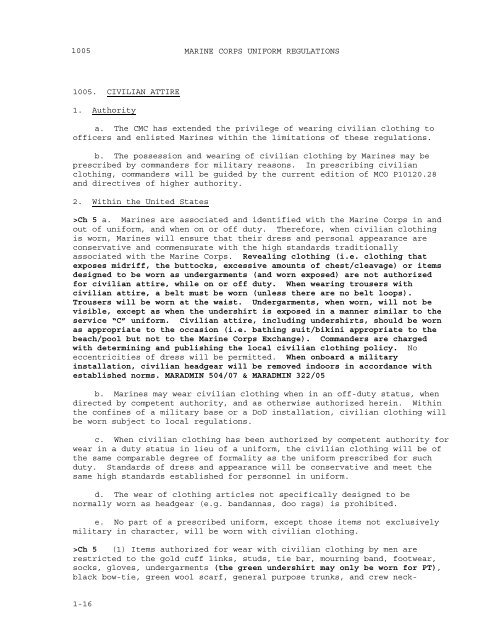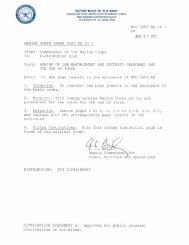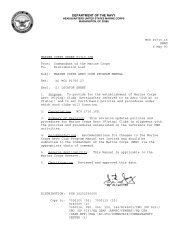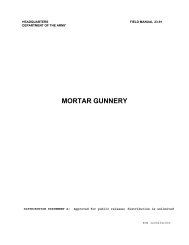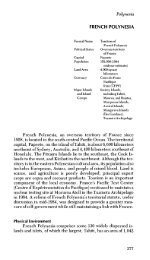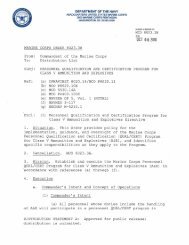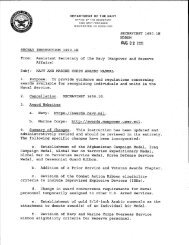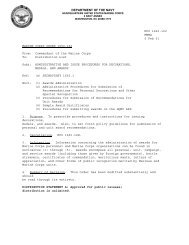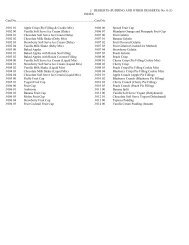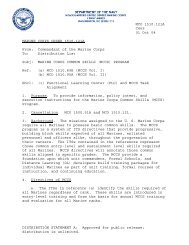MCO P1020.34G W CH 1-5 MARINE CORPS UNIFORM ...
MCO P1020.34G W CH 1-5 MARINE CORPS UNIFORM ...
MCO P1020.34G W CH 1-5 MARINE CORPS UNIFORM ...
Create successful ePaper yourself
Turn your PDF publications into a flip-book with our unique Google optimized e-Paper software.
1005<br />
1005. CIVILIAN ATTIRE<br />
1. Authority<br />
1-16<br />
<strong>MARINE</strong> <strong>CORPS</strong> <strong>UNIFORM</strong> REGULATIONS<br />
a. The CMC has extended the privilege of wearing civilian clothing to<br />
officers and enlisted Marines within the limitations of these regulations.<br />
b. The possession and wearing of civilian clothing by Marines may be<br />
prescribed by commanders for military reasons. In prescribing civilian<br />
clothing, commanders will be guided by the current edition of <strong>MCO</strong> P10120.28<br />
and directives of higher authority.<br />
2. Within the United States<br />
>Ch 5 a. Marines are associated and identified with the Marine Corps in and<br />
out of uniform, and when on or off duty. Therefore, when civilian clothing<br />
is worn, Marines will ensure that their dress and personal appearance are<br />
conservative and commensurate with the high standards traditionally<br />
associated with the Marine Corps. Revealing clothing (i.e. clothing that<br />
exposes midriff, the buttocks, excessive amounts of chest/cleavage) or items<br />
designed to be worn as undergarments (and worn exposed) are not authorized<br />
for civilian attire, while on or off duty. When wearing trousers with<br />
civilian attire, a belt must be worn (unless there are no belt loops).<br />
Trousers will be worn at the waist. Undergarments, when worn, will not be<br />
visible, except as when the undershirt is exposed in a manner similar to the<br />
service “C” uniform. Civilian attire, including undershirts, should be worn<br />
as appropriate to the occasion (i.e. bathing suit/bikini appropriate to the<br />
beach/pool but not to the Marine Corps Exchange). Commanders are charged<br />
with determining and publishing the local civilian clothing policy. No<br />
eccentricities of dress will be permitted. When onboard a military<br />
installation, civilian headgear will be removed indoors in accordance with<br />
established norms. MARADMIN 504/07 & MARADMIN 322/05<br />
b. Marines may wear civilian clothing when in an off-duty status, when<br />
directed by competent authority, and as otherwise authorized herein. Within<br />
the confines of a military base or a DoD installation, civilian clothing will<br />
be worn subject to local regulations.<br />
c. When civilian clothing has been authorized by competent authority for<br />
wear in a duty status in lieu of a uniform, the civilian clothing will be of<br />
the same comparable degree of formality as the uniform prescribed for such<br />
duty. Standards of dress and appearance will be conservative and meet the<br />
same high standards established for personnel in uniform.<br />
d. The wear of clothing articles not specifically designed to be<br />
normally worn as headgear (e.g. bandannas, doo rags) is prohibited.<br />
e. No part of a prescribed uniform, except those items not exclusively<br />
military in character, will be worn with civilian clothing.<br />
>Ch 5 (1) Items authorized for wear with civilian clothing by men are<br />
restricted to the gold cuff links, studs, tie bar, mourning band, footwear,<br />
socks, gloves, undergarments (the green undershirt may only be worn for PT),<br />
black bow-tie, green wool scarf, general purpose trunks, and crew neck-


